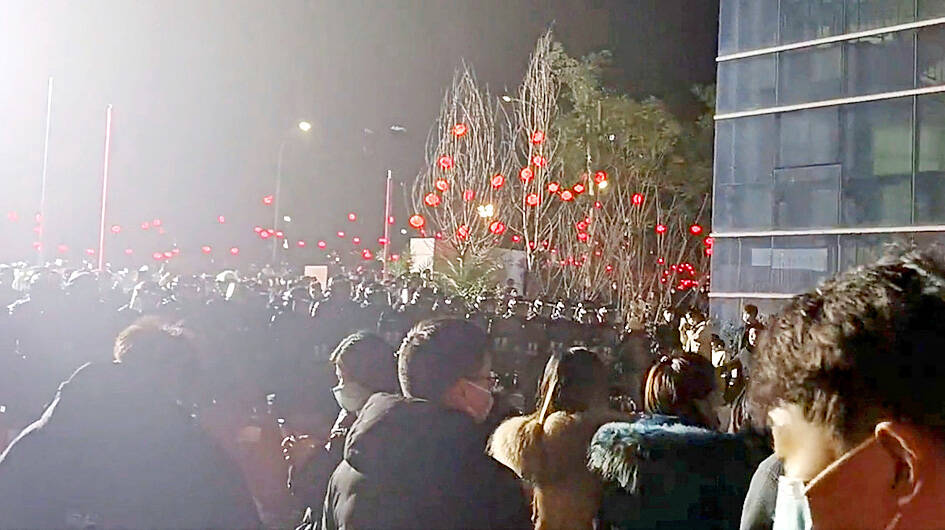Scores of workers have clashed with police at a COVID test kit factory in China, video spreading on social media showed yesterday, as the country navigates a path out of its “zero COVID-19” policy.
Footage geolocated to an industrial park in the southwestern city of Chongqing showed people tossing crates at a group of uniformed men, sending a shower of what appear to be test kits flying.
Another clip showed a crowd in front of a line of police officers at night as loudspeakers play a warning demanding they “cease illegal activities.”

Photo: Reuters
A man who posted video from the scene said in an accompanying caption that many workers had not been paid.
Other posts alleged that Chongqing-based pharmaceutical company Zybio Inc (中元匯吉) suddenly fired workers who had only been recruited weeks earlier.
Zybio did not immediately respond to requests for comment, while the local police department declined to comment.
“All the workers’ demands are economic in nature,” said a man in one video who called himself a “Marxist-Leninist-Maoist.”
He said there was no political motive behind the protest.
Agence France-Presse could not confirm exactly when the videos were captured, although multiple social media users said the clash took place on Saturday night into yesterday morning.
Distinctly patterned brown-and-white industrial buildings can be seen in the background of the videos, matching previous images of Zybio’s facility in the Dadukou District Jianqiao Industrial Park.
The hashtag “Chongqing Dadukou Pharmaceutical Factory” appeared to be censored on Sina Weibo yesterday, with only one post from the previous day still visible describing the protest as an “interesting topic.”
One video posted on a TikTok account belonging to a state-owned news company showed what it claimed was a street littered with antigen tests in a Chongqing industrial park.
“Sources say a labor dispute triggered conflict,” the caption read.
The video was taken down within hours.
Protests centered on labor issues and targeting individual companies occur frequently in China, despite official efforts to clamp down on unrest.
COVID-19 case numbers are presumed to have soared across the country, as the Chinese government moves away from its zero-tolerance approach to the virus, after strict COVID-19 curbs in November last year sparked some of the country’s worst unrest in years.

The US dollar was trading at NT$29.7 at 10am today on the Taipei Foreign Exchange, as the New Taiwan dollar gained NT$1.364 from the previous close last week. The NT dollar continued to rise today, after surging 3.07 percent on Friday. After opening at NT$30.91, the NT dollar gained more than NT$1 in just 15 minutes, briefly passing the NT$30 mark. Before the US Department of the Treasury's semi-annual currency report came out, expectations that the NT dollar would keep rising were already building. The NT dollar on Friday closed at NT$31.064, up by NT$0.953 — a 3.07 percent single-day gain. Today,

‘SHORT TERM’: The local currency would likely remain strong in the near term, driven by anticipated US trade pressure, capital inflows and expectations of a US Fed rate cut The US dollar is expected to fall below NT$30 in the near term, as traders anticipate increased pressure from Washington for Taiwan to allow the New Taiwan dollar to appreciate, Cathay United Bank (國泰世華銀行) chief economist Lin Chi-chao (林啟超) said. Following a sharp drop in the greenback against the NT dollar on Friday, Lin told the Central News Agency that the local currency is likely to remain strong in the short term, driven in part by market psychology surrounding anticipated US policy pressure. On Friday, the US dollar fell NT$0.953, or 3.07 percent, closing at NT$31.064 — its lowest level since Jan.

The New Taiwan dollar and Taiwanese stocks surged on signs that trade tensions between the world’s top two economies might start easing and as US tech earnings boosted the outlook of the nation’s semiconductor exports. The NT dollar strengthened as much as 3.8 percent versus the US dollar to 30.815, the biggest intraday gain since January 2011, closing at NT$31.064. The benchmark TAIEX jumped 2.73 percent to outperform the region’s equity gauges. Outlook for global trade improved after China said it is assessing possible trade talks with the US, providing a boost for the nation’s currency and shares. As the NT dollar

The Financial Supervisory Commission (FSC) yesterday met with some of the nation’s largest insurance companies as a skyrocketing New Taiwan dollar piles pressure on their hundreds of billions of dollars in US bond investments. The commission has asked some life insurance firms, among the biggest Asian holders of US debt, to discuss how the rapidly strengthening NT dollar has impacted their operations, people familiar with the matter said. The meeting took place as the NT dollar jumped as much as 5 percent yesterday, its biggest intraday gain in more than three decades. The local currency surged as exporters rushed to